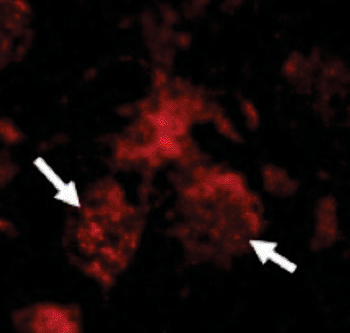Enzyme Deficiency Improves Clinical Picture in Mouse Model of Gaucher's Disease
By LabMedica International staff writers
Posted on 10 Feb 2014
Blocking the activity of a specific enzyme reversed the clinical symptoms of Gaucher's disease (GD) in a mouse model of this hereditary lipid storage disease.Posted on 10 Feb 2014
GD is a hereditary disease caused by a recessive mutation in a gene located on chromosome 1 that causes a deficiency of the enzyme glucocerebrosidase. This enzyme acts on the fatty acid glucosylceramide, and when the enzyme is defective, glucosylceramide accumulates, particularly in white blood cells, most often macrophages. Glucosylceramide can also collect in the spleen, liver, kidneys, lungs, brain, and bone marrow. Clinical manifestations may include enlarged spleen and liver, liver malfunction, skeletal disorders and bone lesions that may be painful, severe neurological complications, swelling of lymph nodes, distended abdomen, a brownish tint to the skin, anemia, low blood platelets and yellow fatty deposits on the white of the eye.

Image: Elevation of RIPK3 in nuclei of neurons (red; arrows) from neuronopathic Gaucher's disease mice (Photo courtesy of Dr. Anthony Futerman, Weizmann Institute of Science).
Investigators at the Weizmann Institute of Science (Rehovot, Israel) examined the role of the enzyme Ripk3 (receptor-interacting serine-threonine-protein kinase 3) in GD. Ripk3, the product of the RIPK3 gene, is predominantly localized to the cytoplasm, and can undergo nucleocytoplasmic shuttling dependent on novel nuclear localization and export signals. It is a component of the tumor necrosis factor (TNF) receptor-I signaling complex, and can induce apoptosis and weakly activate the transcription factor NF-kappaB.
To study the relationship between Ripk3 and GD the investigators used a GD mouse model that included animals with and without active Ripk3. Results published in the January 19, 2014, online edition of the journal Nature Medicine revealed that Ripk3 deficiency substantially improved the clinical course of GD in the mice, with increased survival and motor coordination and salutary effects on cerebral as well as hepatic injury. Furthermore, the lifespan of these mice was remarkably increased, from approximately 35 days to more than 170 days.
“If successful, the new target could be used as either a complementary or alternative therapy for Gaucher's disease, and with RIPK3 proving to be a "hot" cellular pathway in various pathologies, these results may also have implications in other neurodegenerative diseases, including related diseases such as Krabbe disease, and potentially other devastating brain diseases,” said senior author Dr. Anthony Futerman, professor of biological chemistry at the Weizmann Institute of Science.
Related Links:
Weizmann Institute of Science













